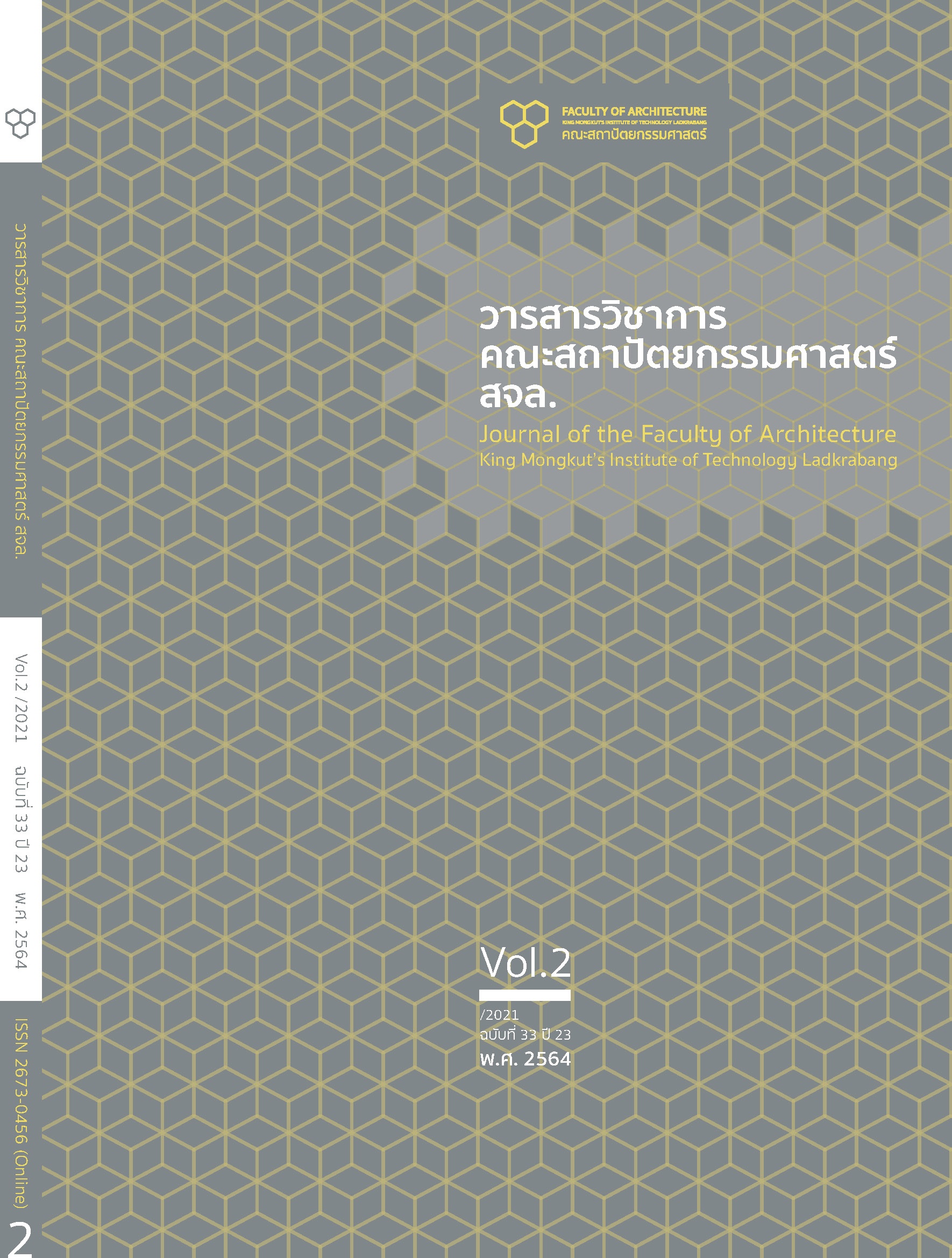Factors of Website Data and Website Quality That Affect the Satisfaction of Using a Website for Interior Design, Case Study: Interior Architecture Students
Main Article Content
Abstract
The aim of this research is to study the factors of websites that affect the satisfaction of using a website for Interior Design of Interior Architecture students. In the Interior Architecture course, the instructor encourages students to study by themselves, by searching from a variety of resources including design websites. The results of the website factor study will be a criterion for teachers to consider a quality website for students or students to consider the appropriate website by themselves and website developers can use this factor in website development. This research is a study of website factors by using 8 website design criteria together with students' research to use information in design. The case study was based on a preliminary study with qualitative research by interviewing 59 students, which summarized 6 websites as follows: Pinterest, Archdaily, Arch20, Houzz, Dezeen and Ignant. Research data were collected by questionnaires from 221 Interior Architecture students and analyzed by statistical programs. The result of this research can summarize the websites that students use in researching are Pinterest and Arcdaily. As for the criteria, the students used in considering the selection of the website are the data factor on the website, divided into 3 groups: 1) Data criteria for internal architectural construction: material properties system work in the building, design pictures, layouts, and furniture pictures, 2) conceptual design data: concept, content, and design pictures, 3) designer information: designer biography, job description, and design pictures, and website quality factor, divided into 2 groups: 1) Website Design Criteria: image clarity, classification, file downloads for consistent use in many systems, simplicity, uniqueness, and quality of graphics, 2) data quality criteria: Designer information, design description, data integrity, navigation, and quality of graphics.
However, these websites have enough factors and information to design, but the students suggested more construction information, such as the process of improving the design and the construction process. This is an issue that should be studied further to be presented on the website in the future.
Article Details
This work is licensed under a Creative Commons Attribution-NonCommercial-ShareAlike 4.0 International License.
Copyright Transfer Statement
The copyright of this article is transferred to Journal of The Faculty of Architecture King Mongkut's Institute of Technology Ladkrabang with effect if and when the article is accepted for publication. The copyright transfer covers the exclusive right to reproduce and distribute the article, including reprints, translations, photographic reproductions, electronic form (offline, online) or any other reproductions of similar nature.
The author warrants that this contribution is original and that he/she has full power to make this grant. The author signs for and accepts responsibility for releasing this material on behalf of any and all co-authors.
References
กุลชลี ไชยนันตา และ ธีระวัฒน์ จันทึก. (2559). องค์ประกอบของการคัดเลือกใช้บริษัทตัวแทนเพื่อศึกษาต่อประเทศสิงคโปร์. Veridian E-Journal, Silpakorn University. 9(3), 1173-1189.
ดวงพร เกี๋ยงคำ และ วงศ์ประชา จันทร์สมวงศ์. (2546). คู่มือสร้างเว็บไซต์ด้วยตนเองฉบับสมบูรณ์. กรุงเทพฯ: โปรวิชั่น.
ธวัชชัย ศรีสุเทพ. (2544). คู่มือการออกแบบเว็บไซต์ฉบับมืออาชีพ: คัมภีร์ Web Design. กรุงเทพฯ: โปรวิชั่น.
นิจสิรีห์ แววชาญ. (2560). พฤติกรรมการเรียนรู้ของนักศึกษาสถาปัตยกรรมภายใน กรณีศึกษาหลักสูตรสถาปัตยกรรมภายใน สถาบันเทคโนโลยีพระจอมเกล้าเจ้าคุณทหารลาดกระบัง. วารสารวิชาการคณะสถาปัตยกรรมศาสตร์ สจล. 25(2), 107-123.
นิทัศน์ อิทธิพงษ์. (2544). การพัฒนาหลักการออกแบบเว็บเพจการศึกษาตามรูปแบบเว็บไซต์ยอดนิยมของคนไทย. (วิทยานิพนธ์หลักสูตรครุศาสตรมหาบัณฑิต สาขาวิชาโสตทัศนศึกษา บัณฑิตวิทยาลัย จุฬาลงกรณ์มหาวิทยาลัย).
เนณุภา สุภเวชย์. (2548). การออกแบบและพัฒนาเว็บไซต์สถาบันการศึกษา: กรณีศึกษา คณะอักษรศาสตร์ จุฬาลงกรณ์มหาวิทยาลัย. วารสารบรรณารักษศาสตร์. 25(2), 57-93.
ผดุงเกียรติ เลาหกิตสนา. (2554). ทฤษฎีการออกแบบเว็บไซต์. เข้าถึงได้จาก: http://patamweb.blogspot.com/2011/05/freelance-graphic-design-2d-3d-logo.html
ภาศิริ เขตปิยรัตน์. (2553). การประเมินความพึงพอใจของนักศึกษาที่มีต่อหลักสูตรบริหารธุรกิจ คณะวิทยาการจัดการ มหาวิทยาลัยราชภัฏอุตรดิตถ์. กรุงเทพมหานคร: ฐานข้อมูลโครงสร้างพื้นฐานภาครัฐด้านวิทยาศาสตร์และเทคโนโลยี กระทรวงวิทยาศาสตร์และเทคโนโลยี.
วีระยุต ขุ้ยศร. (2557). ปัจจัยที่ทำให้เกิดความคิดสร้างสรรค์ในวิชาวิเคราะห์การออกแบบ สาขาวิชาสถาปัตยกรรมและการวางแผน คณะสถาปัตยกรรมศาสตร์ สถาบันเทคโนโลยีพระจอมเกล้าเจ้าคุณทหารลาดกระบัง. วารสารวิชาการคณะ สถาปัตยกรรมศาสตร์ สจล. 18(1), 65-78.
สมชาย บุญสุ่น. (2554). ความพึงพอใจของนิสิตที่มีต่อการเรียนการสอนของมหาวิทยาลัยมหาจุฬาลงกรณราชวิทยาลัยจังหวัดพระนครศรีอยุธยา. (วิทยานิพนธ์หลักสูตรพุทธศาสตรมหาบัณฑิต สาขาวิชาการบริหารการศึกษา บัณฑิตวิทยาลัย มหาวิทยาลัยมหาจุฬาลงกรณราชวิทยาลัย).
สุมณฑา พรหมบุญ. (2557). กกอ. กับการยกระดับคุณภาพการอุดมศึกษาไทย. เข้าถึงได้จาก: http://www.mua.go.th/users/he-commission/t-visit%20project/t-visit%20book%202/00--1.pdf
สุรศักดิ์ นามนัย. (2548). การศึกษารูปแบบของหน้าโฮมเพจที่มีผลต่อความพึงพอใจของผู้ใช้บริการอินเทอร์เน็ตในมหาวิทยาลัยมหิดล ศาลายา. (สารนิพนธ์หลักสูตรศึกษาศาสตรมหาบัณฑิต สาขาวิชาเทคโนโลยีการศึกษา บัณฑิตวิทยาลัย มหาวิทยาลัยศิลปากร).
อรรถพร เพชรานนท์. (2539). การออกแบบสถาปัตยกรรมภายใน. กรุงเทพฯ: คณะสถาปัตยกรรมศาสตร์ สถาบันเทคโนโลยี-พระจอมเกล้าเจ้าคุณทหารลาดกระบัง.
Arch20. (2019, March 29). arch2o.com. Retrieved from https://www.arch2o.com/
Archdaily. (2019, March 29). archdaily.com. Retrieved from https://www.archdaily.com/
Dezeen. (2019, March 29). dezeen.com. Retrieved from https://www.dezeen.com/
Horn, D., & Salvendy, G. (2006). Consumer Based Assessment of Product Creativity: A Review and Reappraisal. Human Factors and Ergonomics in Manufacturing. 16(1), 155–175.
Horn, D., & Salvendy, G. (2009). Measuring Consumer Perceptions of Product Creativity: Impact on Satisfaction and Purchasability. Human Factors and Ergonomics in Manufacturing. 19(1), 223–240.
Houzz. (2019, March 29). houzz.com. Retrieved from https://www.houzz.com/
Igant. (2019, March 29). ignant.com. Retrieved from https://www.ignant.com/
Kotler P., & Armstrong G. (2002). Marketing: An Introduction. (6th ed.) New Jersey: Prentice – Hall.
Pinterest. (2019, March 29). pinterest.com. Retrieved from https://www.pinterest.com/


